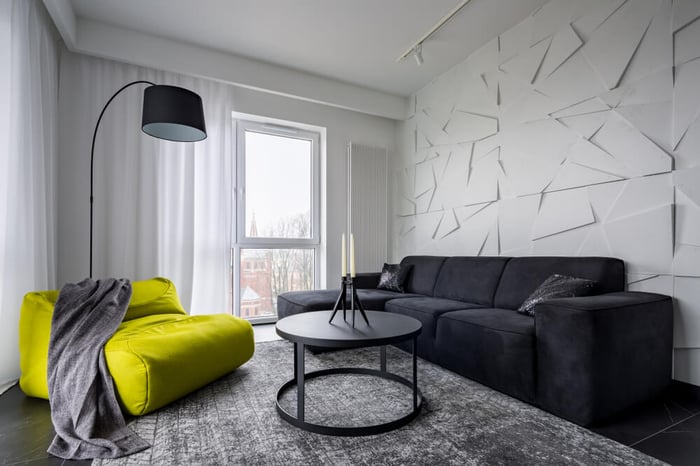Many homeowners want the look of brick or wood on their interior walls, but they don’t want the expense of buying it or the hassle of installing it. So, they look for alternatives. If you’re trying to decide between wood panels and faux-finish wallpaper, the designers at Ninth & Vine want you to know what makes decorative wall panels superior.
Faux Finishes for Walls
Unless your home is filled with architectural details such as crown molding, corbels, columns or wainscoting, you face the challenge of dealing with four flat, empty walls in every room. Choosing fresh paint colors and hanging art on the walls can be fun, but the result is still fairly ordinary.
If we say something “fell flat,” we mean it went poorly. Flat is also a synonym for bland, lifeless, dull, weak and blah. A lot of things are bad if they’re flat: a singing voice, feet, hair, emotions. If you “flat line,” it means you died.
Texture brings a whole new level of interest to a flat space. It’s a bit like the difference between a painting and a sculpture. Each has its merits, but if we were decorating our homes with these works of art, we would want a bit of each, and not all of one or the other.
Walls with texture stimulate the senses, they draw you in visually and bring depth to a space. The rough texture of wood and brick deliver an impact — they’re strong and sturdy-looking and make you feel safe and warm.
Contrast is key in designing a visually interesting room. The concept of accent walls is rooted in this principle. Homeowners have and still do paint a single wall in a room a different color for contrast. This has an impact, albeit less of one than textured wall panels.
When you want to add texture and visual interest to a room, you have to ask yourself how far you want to go, and how to get the most bang for your buck.
Alternatives to Decorative Wall Panels
Whether you chose it for yourself, or your home came with it, oftentimes ceilings or walls can sport textured finishes such as stucco, orange peel or popcorn. More often than not, these techniques are used more to cover up walls and ceilings with imperfections than to add visual interest. They may look OK at first, but all these finishes are a nightmare to keep clean. Their convolutions attract dust and cobwebs, and if you try to remove them with a dust rag, you’ll just make it worse.
Wallpaper is much easier to clean. However, not all walls are suitable for wallpaper.
If your walls are plaster, they are likely not completely flat. You may or may not be able to tell this from looking at your walls in a bright light. But you will notice as soon as you put wallpaper on them.
Unfortunately, wallpaper highlights imperfections in walls. If you have wallboard with dings in it, the wallpaper will not lie smooth over it. Worse, in time, wallpaper installed on walls that are not even and smooth will bubble and buckle.
When you consider the cost of wallpaper and the trouble you must go through to hang it properly, you want it to last for many years.
Seems like you could highlight the “flatness” of wallpaper vs textured wall panels as a negative not just wall imperfections? E.g., brick patterned wallpaper, vs. faux brick?
Faux Brick Wall Paneling
Many of our customers come to our site to shop for faux brick wall paneling. Brick instantly adds warmth and dimension to a space. But real brick — even brick veneer (thin pieces of brick) — is heavy. Installing brick over an entire wall can put a strain on the construction. And if your floors aren’t level (and many aren’t), you’ll need to correct this problem before you start your project.
Installing real brick is also a lot of work. You need adhesives, trowels, spacers and more. Whether you use single brick veneers or preassembled sheets, the danger of waking up the next morning to find some are no longer properly adhered to the wall — or even on the floor — is real.
You don’t have these problems with faux brick wall panels. They’re lightweight and easy to install. Ninth & Vine’s faux brick wall panels come with a peel-and-stick adhesive, so there’s no glue and no mess. Just press the panels onto the wall and you’re done.
Decorative Wood Panels for Walls
Afixing real wood panels to your walls involved nailing, which does damage to the wall underneath. It further presents a challenge because your nails have to hit the studs underneath the wallboard. If you have ever used a stud finder, you understand the frustration that accompanies this semi-reliable tool.
Our customers love our shiplap, available in several shades of white and gray. They immediately give your home a rustic, Colonial look, or a beach vibe, depending on your décor choices. Use them in the office, the bedroom or any room in your home.
Ninth & Vine’s reclaimed wood style panels deliver an urban feel, or an arty or weathered look to your space. You can even use our decorative wood wall paneling in the kitchen — just apply a coat of sealer to keep out moisture to avoid warping.
Other Benefits of Faux Panels for Walls
Depending on the area in which you live and the style of wall you choose, adding textured wall panels can increase your home’s value.
Ninth & Vine’s decorative wall panels aren’t just beautiful, they’re easy to install as well. So, what’s holding you back? Order your textured wall panels today!


